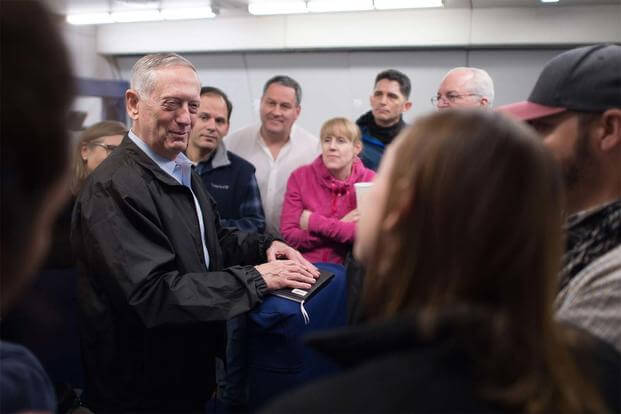Defense Secretary James Mattis was leaving Wednesday for South Korea, where a senator warned that he will be "staring down the barrel of a North Korean ICBM."
The warning from Sen. Bob Corker, a Tennessee Republican and chairman of the Senate Foreign Relations Committee, echoed those of South Korean military officials, who take seriously the threat of North Korean dictator Kim Jong-un that the test launch of an intercontinental ballistic missile capable of reaching the U.S. mainland could come at "any time."
At a committee meeting Tuesday, Corker noted North Korean claims to have miniaturized a nuclear warhead and reports of renewed production of fissionable material by the North. The result is that the U.S. and its allies are now "staring down the barrel of a North Korean ICBM," Corker said.
Last week, Adm. Um Hyun-seong, South Korea's chief of naval operations, warned of the potential of North Korean aggression during the prolonged celebrations of the new Lunar Year, which will coincide with Mattis' visit, South Korea's Yonhap news agency reported.
Kim Jong-un said in his New Year Day's address that his country has entered the final stage of preparations to test-fire an ICBM, indicating it is close to developing a nuclear-tipped missile capable of reaching the U.S.
Mattis' choice of the Far East for his first overseas trip as the new defense secretary is intended to underline the enduring commitment of the U.S. to the region.
He also will seek to reassure allies increasingly concerned about President Donald Trump's withdrawal of the U.S. from the Trans Pacific Partnership trade deal and his complaints about Japan and others not contributing their fair share to defense.
Mattis is scheduled to meet Thursday in Seoul with Acting President and Prime Minister Hwang Kyo-ahn and National Security Office Chief Kim Kwan-jin. On Friday, he is to meet with Defense Minister Han Min-goo before leaving for Japan.
In Tokyo, Mattis is to meet with Prime Minister Shinzo Abe and Defense Minister Tomomi Inada on his two-day visit.
During his stays in South Korea and Japan, Mattis is not expected to bring up the subject of South Korea and Japan paying more to host U.S. forces, according to U.S. and Japanese sources cited by the Japan Times newspaper.
Ahead of Mattis' visit, Joint Chiefs Chairman Gen. Joseph Dunford spoke by phone with his South Korean counterpart, Gen. Lee Sun-jin. The two agreed that "an acute security situation" is posed by North Korea's nuclear and missile programs.
"The talks were also aimed at reaffirming the strong commitment of the two countries to building up a joint defense posture as the new U.S. administration takes control," Yonhap reported.
An Unworkable Strategy
In an article Tuesday in Joint Forces Quarterly, Dunford made the blunt assessment that the previous U.S. strategy of containing a conflict with North Korea to the peninsula is no longer possible, given North Korea's military advancements.
"There was a time, not long ago, when we planned for a conflict that might be contained to the peninsula. But today, North Korea's intercontinental ballistic missile, cyber, and space capabilities could quickly threaten the homeland and our allies in the Asia-Pacific region," Dunford said.
"Deterring and, if necessary, defeating a threat from North Korea requires the Joint Force to be capable of nearly instant integration across regions, domains, and functions," he said.
In a briefing for Pentagon reporters Monday, Navy Capt. Jeff Davis, a Pentagon spokesman, said Mattis does not intend to "roll out any big changes in U.S. policy during his trip."
"It will mostly be a chance for him to listen, meet the parties involved there," Davis said, "and make sure we're positioned, going forward, to be able to continue the strong alliances we have. He wants to find out what their concerns are."
Anti-Missile Capabilities
The South Koreans' concerns have mostly been focused on overcoming China's objections to placement of the THAAD system.
The hit-to-kill THAAD system would enhance the U.S. anti-missile capabilities in South Korea that now rely mostly on the Aegis Combat Systems of Arleigh Burke-class destroyers off the coast.
Earlier this month, the U.S. deployed out of Pearl Harbor to the western Pacific the huge Sea-Based X-Band Radar platform to track missile launches. The Navy said the deployment of the SBX with a radar dome 280-feet tall "was not based on any credible threat. However, we cannot discuss specifics for this particular mission while it is underway,"
Outgoing Defense Secretary Ashton Carter said last month that the U.S. would not necessarily attempt to shoot down a North Korean ICBM if it was simply a test or possibly an attempt to place a satellite in space.
However, Carter said the U.S. is prepared to act if tracking showed the missile veering to a course that posed a threat to the U.S. or its allies.
-- Richard Sisk can be reached at Richard.Sisk@Military.com.




























